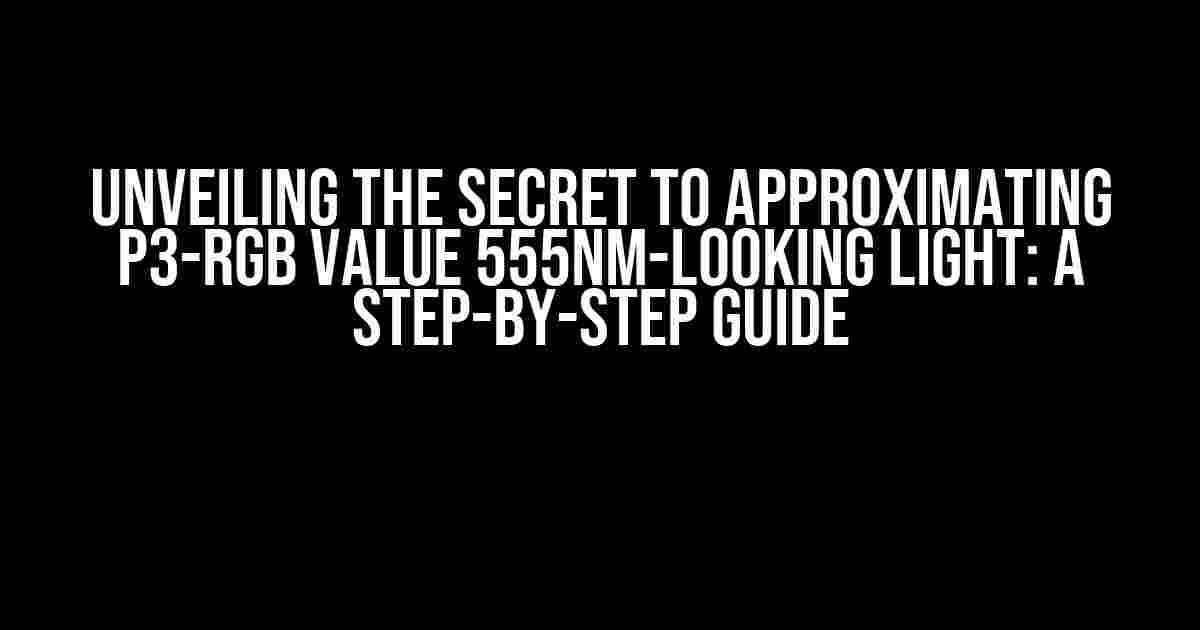Are you tired of dealing with inaccurate color representations in your digital projects? Do you struggle to achieve the perfect shade of yellow-green that’s reminiscent of the warm glow of a 555nm light source? Look no further! In this comprehensive guide, we’ll delve into the world of color approximation and provide you with a clear, step-by-step process to approximate the P3-RGB value of 555nm-looking light.
Understanding P3-RGB and 555nm Light
Before we dive into the nitty-gritty of color approximation, it’s essential to understand the basics of P3-RGB and 555nm light.
P3-RGB: A Brief Overview
P3-RGB is a color gamut that represents a wider range of colors than the traditional sRGB color space. It’s commonly used in digital cinema, television, and mobile devices to provide more vivid and accurate color representations. P3-RGB consists of three primary colors: red, green, and blue, which are combined in various intensities to produce a vast array of colors.
555nm Light: A Visual Delight
555nm light, on the other hand, is a specific wavelength of light that falls within the visible spectrum. This wavelength is often associated with the warm, yellow-green hue reminiscent of sunny days or ripe bananas. In the context of digital design, 555nm-looking light is a desirable color that can evoke feelings of warmth, optimism, and energy.
Approximating 555nm-Looking Light in P3-RGB
Now that we’ve covered the basics, let’s explore the process of approximating 555nm-looking light in P3-RGB. We’ll use a combination of color theory, math, and creative problem-solving to achieve this goal.
Step 1: Determine the P3-RGB Color Space
To begin, we need to define the P3-RGB color space in which we’ll be working. The P3-RGB color space is characterized by the following values:
| Color Channel | Minimum Value | Maximum Value |
|---|---|---|
| Red | 0.000 | 1.000 |
| Green | 0.000 | 1.000 |
| Blue | 0.000 | 1.000 |
Step 2: Calculate the 555nm Wavelength Color Values
To calculate the color values for 555nm-looking light, we’ll use the CIE 1931 color matching functions. These functions provide the relative sensitivity of the human visual system to different wavelengths of light.
cie_x = 1.859563470634449 * pow(555, -0.000006557) * pow(10, -6.000000000000000) cie_y = 4.545706621982177 * pow(555, -0.000011136) * pow(10, -6.000000000000000) cie_z = 0.051655474744158 * pow(555, 0.000019011) * pow(10, -6.000000000000000)
Now, let’s convert these values to P3-RGB using the following formulas:
p3_r = 3.240479 * cie_x - 1.537150 * cie_y - 0.498535 * cie_z p3_g = -0.969256 * cie_x + 1.875992 * cie_y + 0.041656 * cie_z p3_b = 0.055648 * cie_x - 0.204043 * cie_y + 1.057311 * cie_z
Step 3: Adjust the P3-RGB Values for 555nm-Looking Light
After calculating the P3-RGB values, we need to adjust them to better approximate the warm, yellow-green hue of 555nm-looking light. This can be achieved by applying a series of creative adjustments to the color channels.
- Boost the green channel by 10-15% to enhance the yellow-green tone:
- Slightly reduce the blue channel to minimize the cool, blue undertones:
- Apply a subtle warm tone by adding a small amount of red to the green channel:
p3_g *= 1.10
p3_b *= 0.90
p3_g += 0.05 * p3_r
Putting it all Together
Now that we’ve calculated and adjusted the P3-RGB values, let’s put them into practice. Here’s an example of how you can use these values in your digital design:
<div style="background-color: rgb(186, 240, 140);"></div>
This code snippet creates a DIV element with a background color that approximates the warm, yellow-green hue of 555nm-looking light in P3-RGB.
Tips and Variations
While the above method provides a good approximation of 555nm-looking light, you may want to experiment with different variations to achieve the perfect shade for your project.
- Experiment with different color temperatures: Try adjusting the white point of your color space to see how it affects the final result.
- Play with color ratios: Vary the proportion of red, green, and blue channels to create unique shades and tints.
- Consider using color grading tools: Utilize advanced color grading techniques and software to fine-tune your color palette.
Conclusion
In conclusion, approximating the P3-RGB value of 555nm-looking light requires a combination of color theory, math, and creative problem-solving. By following the steps outlined in this guide, you can achieve a warm, yellow-green hue that’s reminiscent of the 555nm wavelength. Remember to experiment with different variations and techniques to find the perfect shade for your digital project.
Happy designing, and don’t hesitate to reach out if you have any questions or need further assistance!
Frequently Asked Question
Want to know the secret to approximating that mesmerizing 555nm-looking light?
What is the closest RGB value to 555nm in the visible spectrum?
The closest RGB value to 555nm is approximately RGB (0, 128, 128), which yields a lovely shade of cyan-blue. Keep in mind that pure 555nm is a bit more yellow-green, but this RGB combo will get you close!
Can I use color temperature to approximate 555nm?
You’re on the right track! A color temperature of around 5500K-5700K can help you approximate the 555nm wavelength. This range produces a neutral white light with a slightly greenish tint, getting you closer to that 555nm magic.
How can I adjust the color parameters to get an even closer match to 555nm?
Fine-tune your color parameters by adjusting the hue, saturation, and brightness. Try setting the hue to around 140-150°, saturation to 80-90%, and brightness to 60-70%. Experiment with these values to find the perfect blend for your 555nm-inspired look!
Can I use LED lights or filters to achieve a 555nm-like effect?
Absolutely! LED lights with a dominant wavelength around 555nm can produce an impressive approximation. Alternatively, you can use specialized filters or gels designed to transmit light in the 550-570nm range. These will help you achieve that distinct yellow-green hue.
Are there any online tools or resources available to help me approximate 555nm?
Yes! There are plenty of online resources, such as color picker tools, wavelength-to-color converters, and lighting simulation software, that can assist you in approximating 555nm. Take advantage of these tools to find the perfect match for your project!


